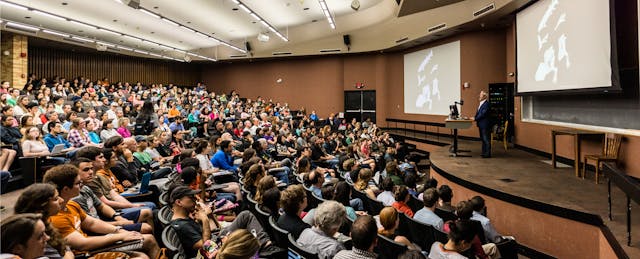There’s an old joke that the original form of distance education is sitting in the back of a large lecture course. Education technology researcher George Siemens and a colleague hope that personalized learning approaches can help better connect professors and students in large classes.
In a new partnership involving six colleges around the world, a team of researchers built OnTask, a software tool that allows professors to organize and pre-write email communications with students. “OnTask identifies the challenges students face and gives regular feedback in the form of a detailed automated email that’s personalized,” says Siemens, director of the LINK Research Lab at the University of Texas at Arlington.
While the combination of “automated” and “personalized” seems contradictory, OnTask aims to deliver targeted guidance to students based on their behavior. Faculty members write their own scripts for the automated emails. “Rather than creating generic messages like ‘pay attention to your study habits,’ we bring in the instructor to provide much more specific messages with links to helpful content, reminders and other study tips,” says Abelardo Pardo, associate professor at the University of Sydney and principal researcher for OnTask. “The text that reaches the students is written entirely by humans, and that makes it a much more personalized conversation.”
Pardo piloted OnTask in March 2017 at the Learning Analytics and Knowledge Conference in Vancouver. “We ran a tutorial with 38 experts at the conference,” he says. “I would say there was a substantial agreement that this type of tool was missing from the market, and OnTask attempts to fill that need.”
OnTask’s success depends heavily on the quality (and quantity) of student data available. Institutions can gather data from several sources, including digital and real-life interactions. “We use data from learning management systems, student information systems, discussion forums, assessments and observation to build a model of the student,” Siemens says. “This data gets compiled and assessed, and we’re able to identify groups of students who display certain attributes.”
For example, if a student misses several classes, gets a low score on an assessment or doesn’t complete the week’s reading, he or she gets a message through OnTask with targeted advice for getting back on track. “OnTask is really about taking all our students—whether they’re struggling, succeeding or just doing okay—and giving them specific guidance,” Siemens say. “We recognize that students may be taking several courses at a time, so we’re giving them exact next steps to take to be successful in the course.”
For professors, OnTask means an initial time investment to write the series of targeted email scripts. “The system clusters the students into categories and provides personalized messages for different groups,” Siemens says. “For faculty who have taught a course before, it’s useful to look through how it’s structured and what’s working or not working—but it’s a time-consuming process.” Siemens says the OnTask team hopes to provide more support in the future to instructors as they’re writing their scripts.
Another challenge facing OnTask’s future is a disparity between data sources at various colleges. “Each institution has a different learning management system infrastructure,” he says. “Even though the tool is LMS agnostic and we have a model for taking data from seven or eight sources, having a different grouping of sources at each university is challenging.”
Pilot programs of OnTask are currently planned and running at UT Arlington and at four Australian universities. A number of other institutions have expressed interest.
Siemens expects OnTask to pave the way for additional software products that address specific problems in higher education. “One of the challenges of competency-based learning is that you have to redo all your curriculum practices,” he says. “It’s good and important work, but it takes five to ten years. Going forward, I expect we’re going to see more toolsets like OnTask that use research and functionality to promote rapid adoption.”
As the project gains momentum, Siemens also plans to survey students to better understand how the tool is working. “The quantitative data shows that they’re more engaged within specific courses, but the qualitative data will take more time to emerge,” he says. “Next year, we’ll start to ask students if they feel more supported and connected as a result of OnTask.”


